Malaga is an enchanting province in Southern Spain, nestled between Seville and Granada in the Autonomous Community of Andalusia. If you’ve read other articles on this blog, you’ll probably know that I have a soft spot for Andalusia. It’s my favorite region in Spain!
But back to Malaga. Acting as a gateway to Spain’s Costa del Sol and the shimmering Mediterranean Sea, it’s one of the most coveted holiday destinations for both locals and foreign visitors.
It’s no surprise, as it’s home to magnificent beaches, historic attractions, and the most picturesque villages you’ll come across. Did you know the famous artist Picasso was also born there?
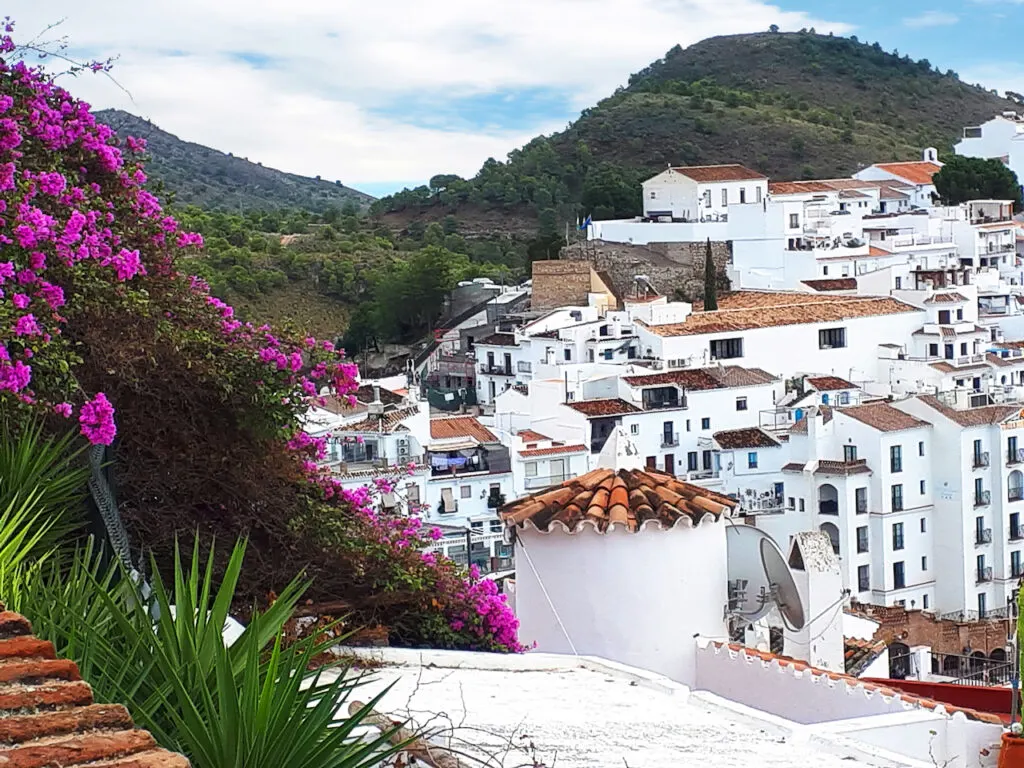
While the city of Malaga and its coastline might be the reason you’re visiting, its culture, architecture, and Instagrammable locations are going to make you wanna stay for a long, long time.
In this article, we’ll cover the most iconic villages near Malaga that simply ought to be on your itinerary. Let’s dive in!
How to Get Around Malaga
Let’s start by differentiating Malaga City, which sits on the shores of the Mediterranean Sea, from the province of Malaga.
The lively, cultural city of Malaga is within its namesake province, and likely where you’ll be staying during your trip. It’s on the coastline, well-connected, and close to the stunning villages you’re about to explore!
Malaga has an efficient bus service network, however I highly recommend renting a car for a journey like this. The bus lines can take you from Malaga to a few different destinations, but they’re not practical to exploring the region and its cute towns with ease.
Having a car enables you to set your own schedule, and also plan an itinerary that makes sense to you. Besides, you’ll be able to reach all the villages in Malaga, even those that are not directly connected to the city by bus.
Once behind the wheel, you’ll be ready to explore this beautiful region of Spain, and plan your day trips as you wish – either visiting one town at a time, or embarking on a road trip to check them all out at once! Your vehicle, your rules.
Villages East of Malaga
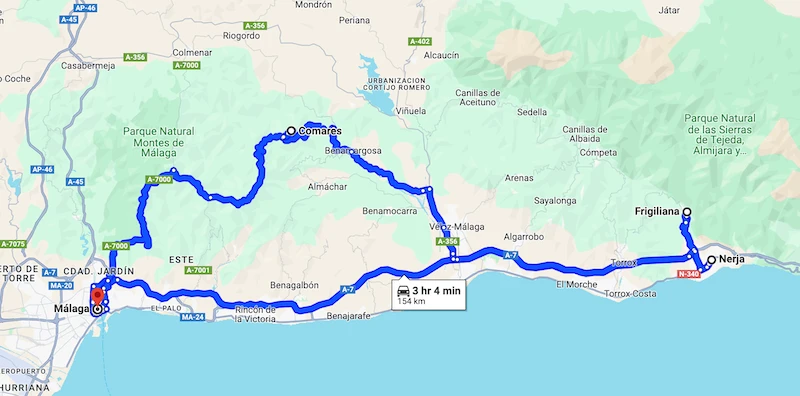
Nerja, Frigiliana and Comares, the first 3 villages below, are located east of Malaga, so I suggest visiting the three villages on a single day trip.
Nerja
Arguably the most sought-after town in Malaga, Nerja is a white-washed village on the seaside, home to beautiful beaches and imposing mountains as a backdrop. It’s considered one of the most beautiful white villages in Andalucia.
One of its major attractions is the one known as Balcon de Europa, Europe’s Balcony, a phenomenal vantage point over the sea that was supposedly named by King Alfonso XII.
It sits on a rocky outcrop where a fortress once stood, and it’s an unmissable spot to check out.
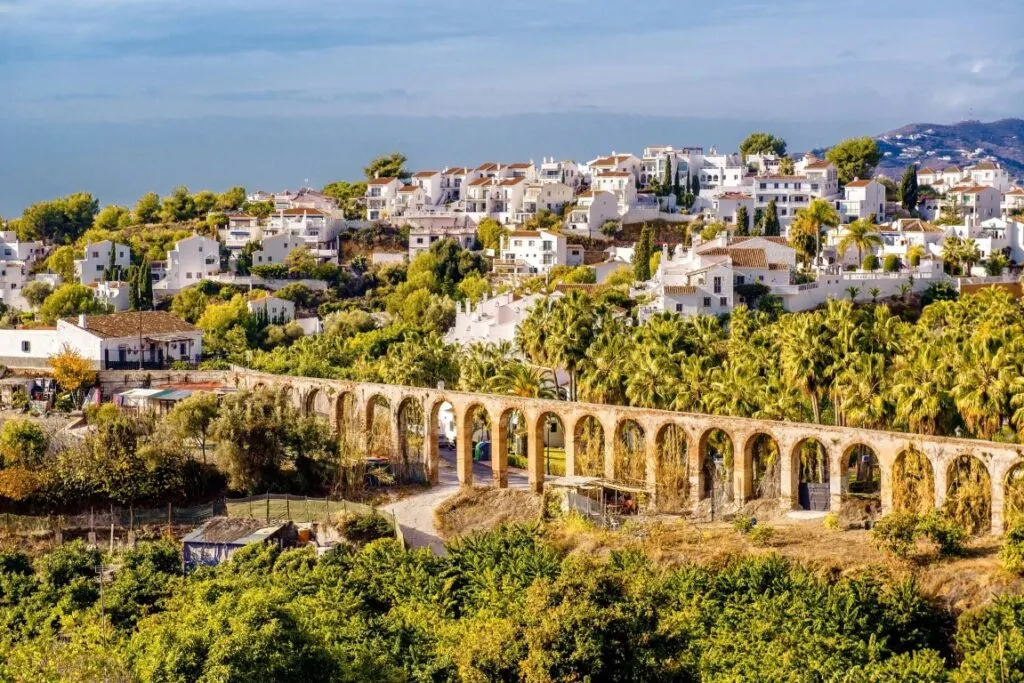
Nerja also boasts a beautiful old town, with shop-lined streets, traditional bars, and the adorable white houses that are a staple in Malaga’s towns.
Other things to do in Nerja include going for a swim in its beautiful beaches, such as Burriana Beach and Calahonda Beach, and sampling local cuisine.
The cold soup ajoblanco, the roasted skewered fish estepo, and the delicious sweet potatoes with miel de cana (cane honey) are a few must-eat dishes. Malaga has, in fact, the only factory in the world that produces this sweet nectar.
Some of the top restaurants to try regional dishes are Bar El Pulguilla, El Refugio, Rincon del Sabor, and Puerta del Mar. Go to the Michelin-recommended Sollun Restaurant for fine dining, and to Chiringuito de Ayo for paella at the beach.
An attraction that you can’t miss when in town is Nerja Cave, a series of caverns that’s almost 3 miles long, and home to the world’s largest stalactite.
The mesmerizing cave is a treat to the eyes, with countless stalagmites, spirals, gours, and stalactites. It also acts as a natural amphitheater, hosting delightful concerts, and has an interesting museum about the city.
▶️ Distance from Malaga: 36 miles (58.5 km). The driving time, along the A-7 motorway, is around 45 minutes.
Frigiliana
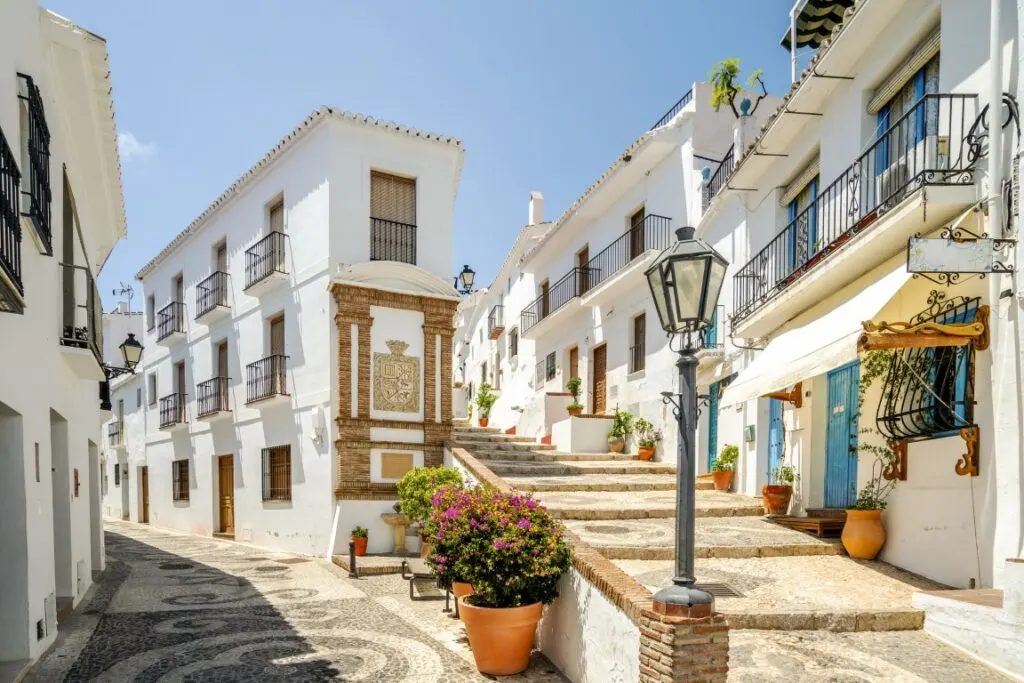
The town of Frigiliana is considered, by many, one of the most beautiful white villages in Spain. It was even voted the prettiest village in Andalusia by the Spanish Tourism Board.
Its historic charm, quaint old town, and Moorish heritage are its main attractives, featuring winding cobblestone streets and white facades, decorated with flower pots and ceramics.
The Archaeological Museum, which was recently moved into a new building, is worth a visit for a cultural and historical immersion in the area. It has displays of over a hundred artifacts from the Neolithic Age all the way to contemporary art pieces.
Frigiliana also boasts the Santa Fiora Botanic Gardens, which has an incredible variety of plants that had served a purpose to the town’s inhabitants over the centuries.
From medicinal herbs to edible plants, and those used to make paper, silk, perfume, or even shoes can be found in the garden. It recounts the history of Frigiliana through nature, and it respects the traditional topography of the terrain, blending effortlessly.
In the old town, you’ll also find cute artisan and pottery shops to do some souvenir shopping before leaving.
If you happen to visit on the last weekend of August, you’ll stumble upon the Three Cultures Festival, which celebrates Frigiliana’s confluence of Muslim, Jewish, and Christian cultures in a four-day event.
▶️ Distance from Malaga: 37 miles (59.7 km).The drive will take you an hour along the A-7 motorway. You can also visit Frigiliana after your trip to Nerja, which is only a 30-minute drive away.
Comares
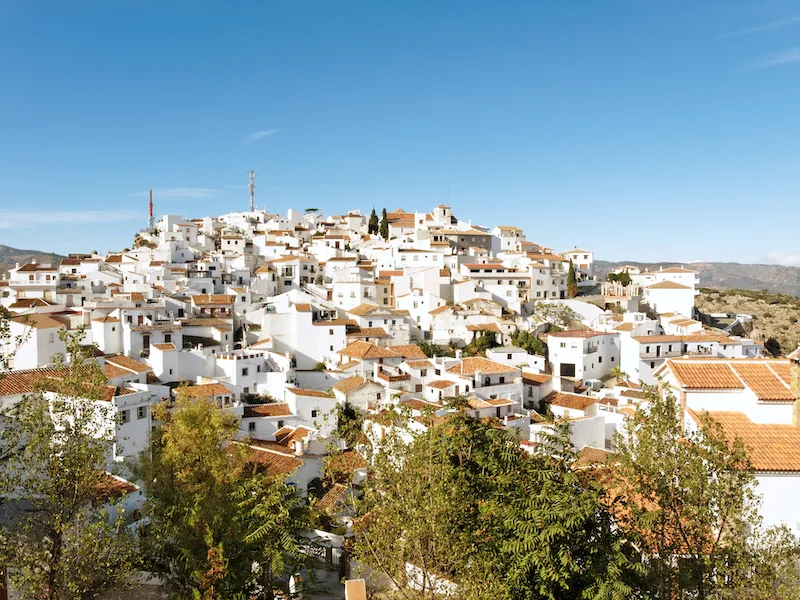
Nerja has the Balcony of Europe, but Comares proudly boasts the Axarquia Balcony, which overlooks the whole region. Located 2300 feet (700 meters) above sea level, the town is a beautiful vantage point on top of being incredibly charming by itself.
It features a great number of interesting monuments which you can explore by following the pretty ceramic footprints located around the village. They make the perfect GPS!
Among them you’ll find Arab archaeological remains that showcase the town’s Moorish past, including the Comares Castle, and remnants of the walls and towers from that period, as well as an ancient cistern.
The town’s main Church, Nuestra Senora de la Encarnacion, was also built on the site of a Moorish Mosque, so there’s a lot of history to uncover in this small but privileged located town.
But that’s not all there is! The adventurers will be glad to know that Comares offers plenty of hiking trails, ziplines, and via ferrata experiences.
And the best part is that you will find cozy family-run establishments where to refuel with a hearty local meal after. A few of the good ones include Bar Pepa (previously known as Bar Los 3 Balcones), Mirador de la Axarquia, and El Molino Restaurant.
▶️ Distance from Malaga: 22.6 miles (36.4 km). The drive to Comares will take you slightly over an hour.
Villages West of Malaga
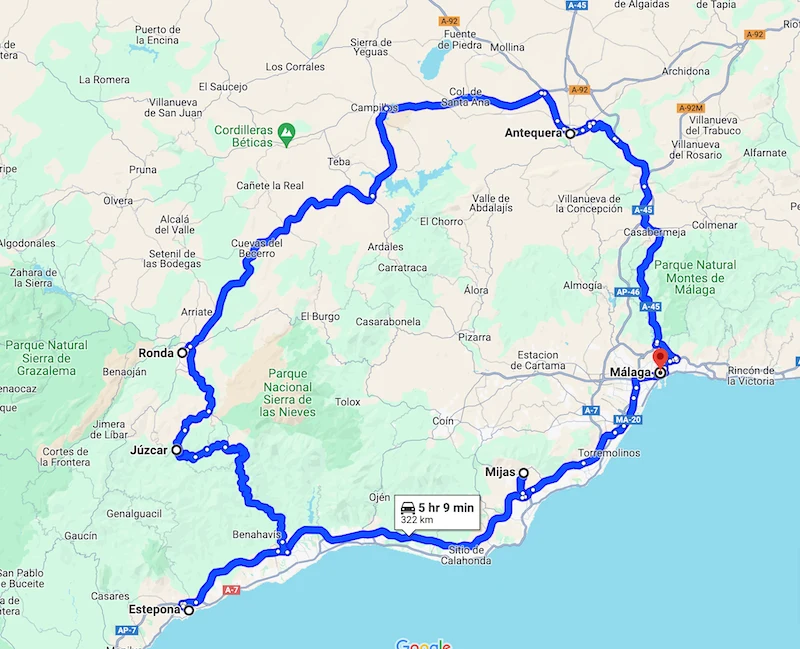
The villages described below are all found west of Malaga City, so you could plan a second day trip to check them all out. You can follow the order of this article to plan your itinerary.
Mijas
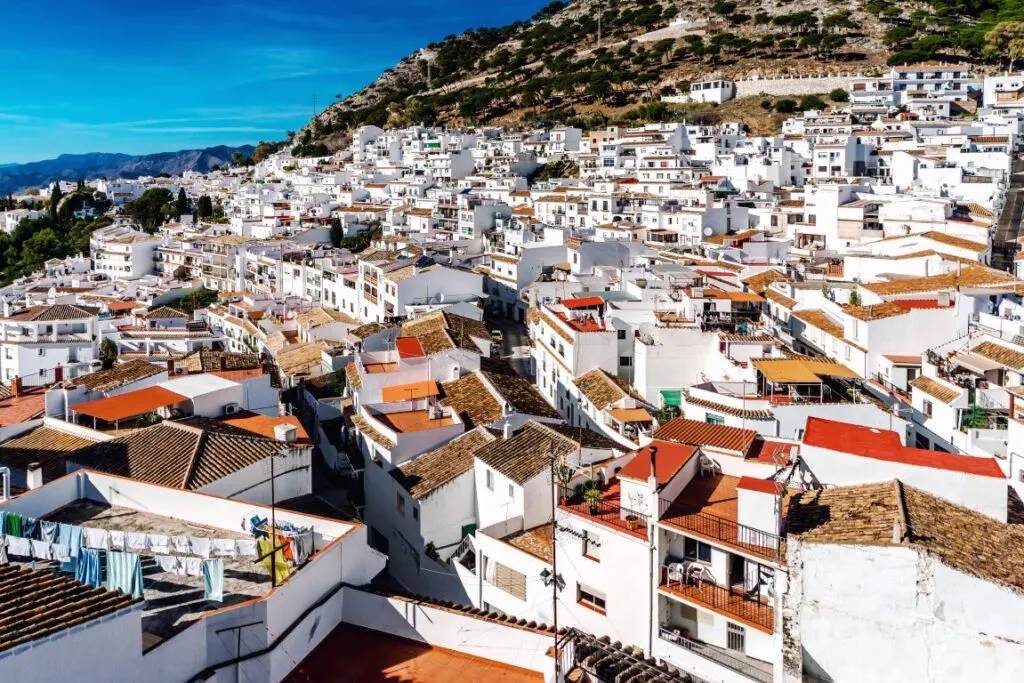
Mijas is a small village situated about 6 miles (10 km) from the coast, nestled in the hills of Sierra de Mijas. It’s a privileged location for enjoying both the sea and mountain activities, and features a very picturesque city center worth checking out.
Its whitewashed buildings, cute stores selling crafts and souvenirs, and the mountains acting as a backdrop of the town make it look straight out of a postcard.
Attractions you can’t miss in Mijas include the ample squares, among which stands out Plaza Virgen de la Pena, which is surrounded by bustling cafés and shops.
The town is also home to one of the country’s oldest bullrings, which has an unusual oval shape, and the Church of the Immaculate Conception, built on the remains of a Mosque.
Wine connoisseur? Mijas is also renowned for its wine production, and you’ll find several shops in town, such as Amor a Malaga and La Bodega del Pintor where you can learn about the wine-making of the region, sample varietals, and get the chance to purchase local wines.
You won’t be able to escape the colorful flower pots, which are a staple of Andalusian architecture, and the picturesque arched alleyways either. Prepare for a visit that’s cultural, pretty, and delicious!
▶️ Distance from Malaga: 20.5 miles (33 km). The drive shouldn’t take longer than 30 minutes along the AP-7 motorway.
Estepona
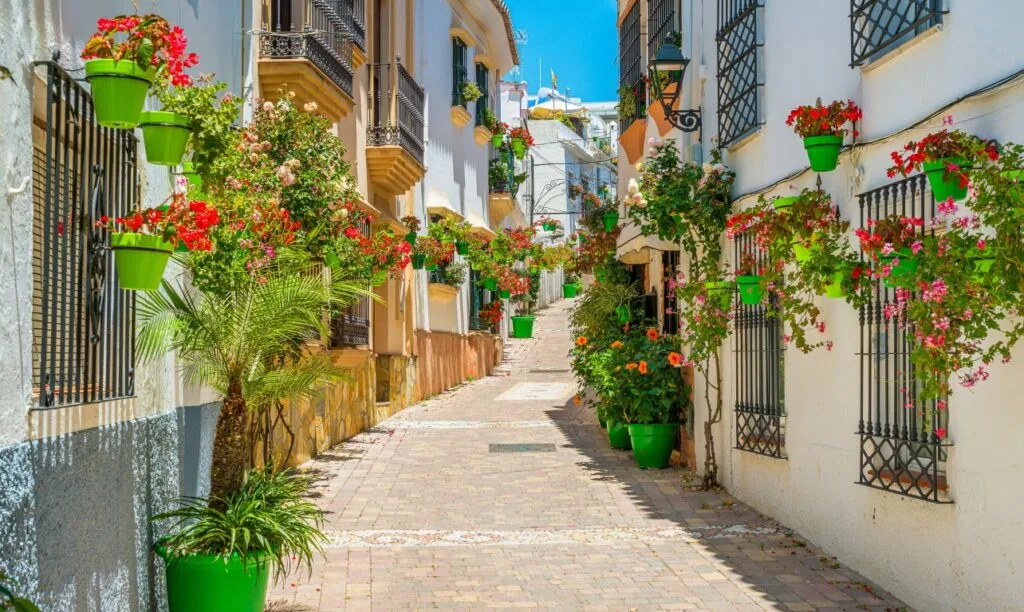
Estepona is a resort town on the Mediterranean coast, also referred to as the Garden of Costa del Sol. Its layout truly makes it an urban garden, with winding streets lined by massive flower pots and plants.
Culture and art play a very important role in Estepona, and you’ll find no shortage of sculptures and delightful street art dotting the town. That’s on top of the first-rate amenities that come with being a popular beachside holiday destination.
Golf clubs, fine restaurants, Blue Flag beaches, an enchanting marina, shops, and the prettiest old town are a few of the places you shouldn’t miss in this coastal town near Malaga.
If you happen to visit on a Sunday, you’ll get to explore the bustling street market that sells everything from arts and crafts to tasty bites and regional products.
▶️ Distance from Malaga: 55 miles (98 km). The drive to Estepona takes approximately an hour and 15 minutes along the AP-7 motorway.
Juzcar
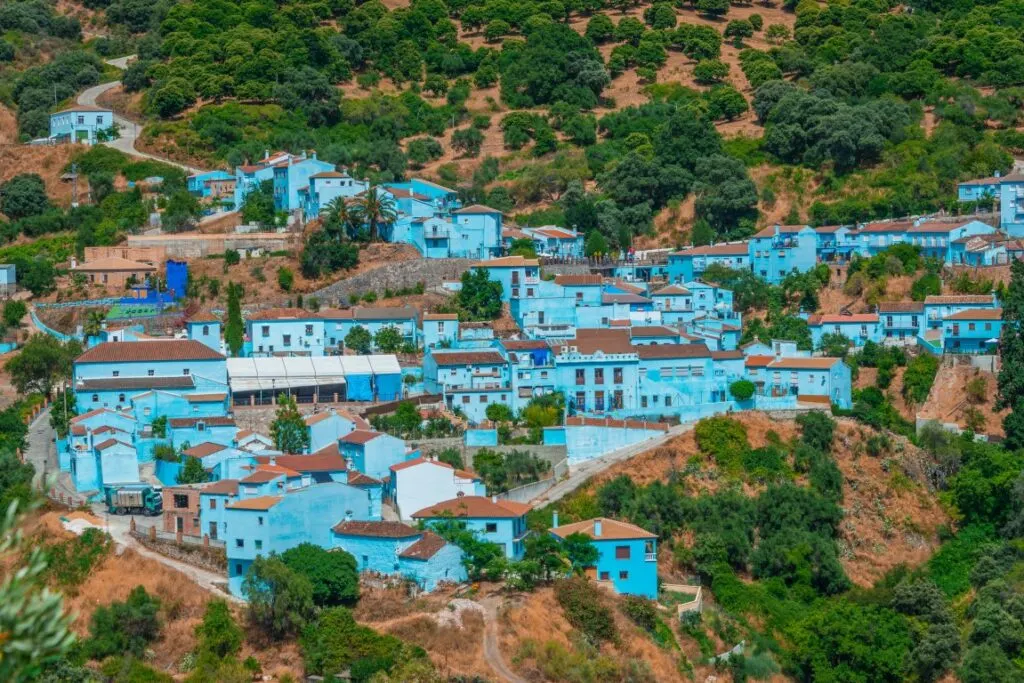
Juzcar is the town of the Smurfs. No, I’m not messing with you. This famed Spanish town stands out from the other towns near Malaga because it’s not white, as seems to be the standard, but blue. And it’s actually referred to as Smurf Village, although officially, because of copyright issues, it’s the Blue Village.
The town has been a preferred destination for rural tourism for years, as it offers fantastic hiking and climbing. However, its visitors have increased greatly since turning into a blue sea of buildings, which include houses, the Town Hall, the Church, and even the cemetery.
Smurf sculptures live in the balconies and squares of the village, and murals add life to the blue walls.
This drastic make-over was part of a publicity stunt by the film company to promote the
The Smurfs 3D movie, but Juzcar inhabitants embraced the influx of tourism that accompanied it, and decided to keep it that way.
Besides getting lots of Instagram shots, and exploring the natural landscapes that surround it, you can zipline, relish local tapas at the various bars, check out the views from the Torrichela viewpoint, and get lost in the enchanting blue streets.
▶️ Distance from Malaga: 70 miles (112.5 km). The ride along the AP-7 motorway will take approximately 1 hour and 45 minutes.
Ronda
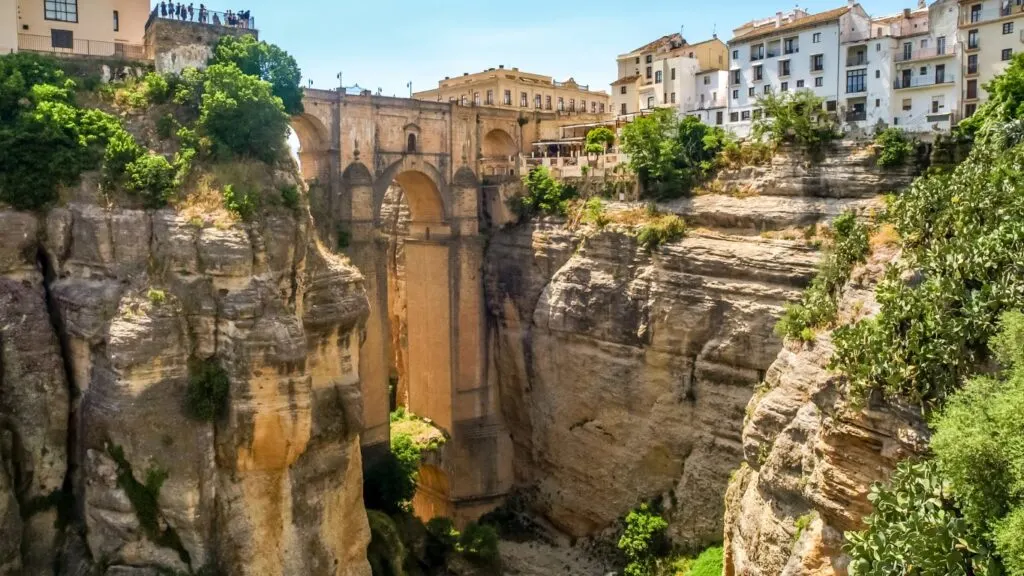
Ronda is more a city than a village, home to slightly over 30 thousand inhabitants. But we just couldn’t exclude it from this list! The iconic Andalusian location is probably one of the most striking in Southern Spain, and that’s saying something.
Ronda is built on a cliffside, with a deep canyon, El Tajo, separating the old and new towns – which date back to around the 15th century and Moorish times respectively.
There’s an impressive bridge, Puente Nuevo, joining both sides of the gorge, which makes for an unbeatable viewpoint.
Other attractions to check out in Ronda include the bullring, the historic quarter with its church, and the ancient Arab Baths. History and architecture combine in this city to make it one of the most photogenic and fascinating of Southern Spain.
▶️ Distance from Malaga: 63 miles (102 km). You’ll have to take the Autovía A-45 and the A-367 road to reach it. The drive will take you slightly less than 1.5 hours.
Antequera
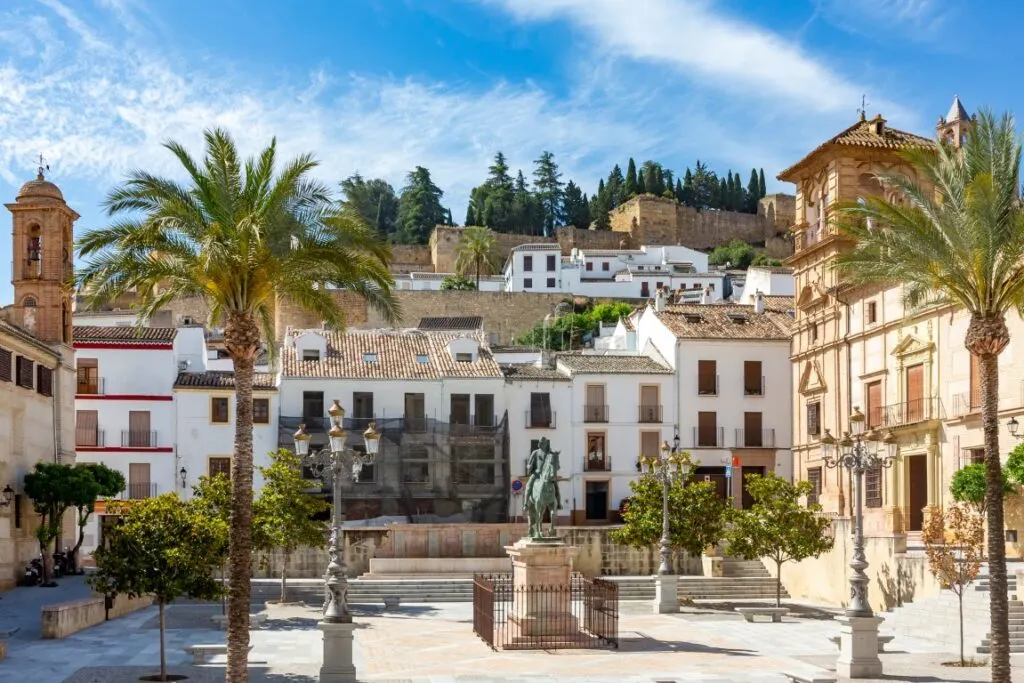
Arguably the most famous attraction in Antequera, a quaint town with incredible landscapes and history, is the Dolmens of Antequera Archaeological Site. This UNESCO-listed location comprises three monuments, which date back to the Neolithic and Bronze Ages.
The megalithic structures are among the best preserved examples of architecture from ancient Europe, and were used as burial chambers. Their cultural value is immense, and they’re striking to the eye!
Antequera is also home to a centuries-old Moorish fortress, the Alcazaba, from where the views over the city are unparalleled.
Other worthy landmarks include Antequera’s 33 churches, most of which boast Baroque architecture, and the outstanding rock formations of El Torcal.
▶️ Distance from Malaga: 35 miles (57 km). You’ll drive north of Malaga along the A-45 for 50 minutes to get to Antequera.
